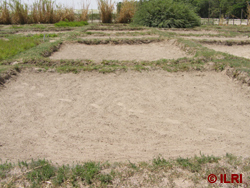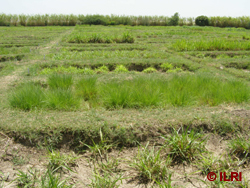Articles
Storage in field banks (forage grass)
Contributors to this page: ILRI, Ethiopia (Jean Hanson).
Describes the most important procedures during the storage/conservation of forage grasses in field banks. Best practices are shown in a pale blue color with bullets.
Storage specifications
Field preparation
- Select the environment and soil type best suited for the species (see table).
- Soil should be ploughed and disked, weeds and grasses removed. The soil should be prepared by tillage to obtain a well prepared and level seed bed prior to planting.
Field planting
- Planting should be done at the start of the rainy season (to aid establishment).
- Aim for a final plant number of 30 in plots of 10m2 for vegetatively propagated grasses.
- Plant in 3 rows of 5m long, each row 100cm apart with within row spacing of 50cm giving a density of 30 plants per plot. See table, for more specific information about density of each species.
 |
 |
|
Empty plots waiting to be planted in the grass field genebank of Zwai, Ethiopia (photo: ILRI) |
Grass field genebank in Zwai, Ethiopia |
Frequency of new establishment
- It depends on the species and their growth rate, but generally should be done every 3-5 years.
Field maintenance and management
Weed management:
- Early growth can be slow and hand weeding 4 weeks after establishment is recommended.
- Eliminate plants growing off-row. Rogue out plants that are genuine mixtures.
Irrigation:
- Irrigate the field after sowing and when needed subsequently. Do not allow the leaves to wilt at any stage. Ensure enough moisture in soil at the time of flowering.
Fertilization:
- It is recommended to apply Phosphorous at planting using DAP at 100kg per hectare. An additional application of 50-60kg N per ha as a top dressing at early flowering stage will ensure good seed quality.
Common pest and diseases:
- Forage grasses are susceptible to many fungal diseases and few virus and phytoplasma (see table, for the most often detected pests and diseases).
Pest and disease control:
- Spray with fungicide to control mildew during the rainy season or when using irrigation and with insecticide at the first sign of insect damage. Pay particular attention to army worm and spray at the first infestation.
Renovation of field bank:
- It is the regular maintenance of an existing field, bycutting the plants.
- It should be regularly done twice or three times a year (to control pests and diseases, to promote young growth and flowering).
Harvesting seeds from grass field banks
Sometimes, there is a need to collect seeds from field genebanks, already established, in order to increase some seed stocks (many grasses have short lived seeds or shy seeds – i.e. do seed but rarely have a few caryopsis), often required to overcome difficulties in distributing vegetative materials (due to pests and diseases, quarantine regulations or high volume /cost of transportation). In these cases, there is a need to isolate the seeds so they do not cross pollinate, and there are two main options to harvest seeds for dispatch:
Isolation
- Spatial isolation - generally 100m between any related species.
- Temporal isolation – cut back all neighboring related species (within 100m) to prevent flowering, during flowering period.
Bagging and tagging
- Bag the inflorescences (a bunch of them) to avoid contamination with foreign pollen during flowering time, tag each stem for easier identification and harvest the seeds later on.
Storage management
System for tracking materials/inventory system in field banks
- Use a database for stock and location.
- Use pegs, tags or bar codes for labeling.
- Use impermeable ink and write clearly (databases are needed to keep track of information).
- Plots must be well labeled to avoid errors.
- Bar codes help avoid errors in recording.
Recording information during storage in field banks
The following information should be recorded during storage:
- Accession number (an ID number).
- Genus (genus name of the plant, entered in full).
- Species (species name of the plant, entered in full).
- Field genebank site name (a code to indicate the site of seed production).
- Plot number (the plot number at the production site).
- Plot size (plot size in square meters).
- Date of planting (the date that the planting was carried out).
- Type of planting (a code for the method used for planting (seed, cutting etc)).
- Number of plants (the total number of plants in a plot).
- Spacing within row (the space (in cm) between plants in a row).
- Spacing between rows (the space (in cm) between rows in a plot).
Comments
- No comments found

Leave your comments
Post comment as a guest